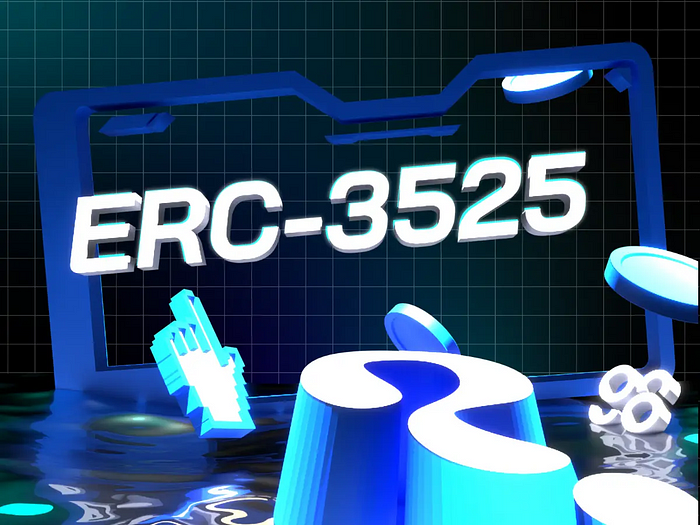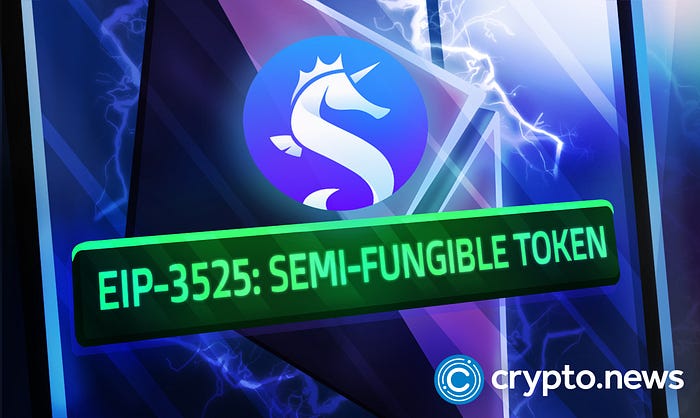What is ERC-3525 — from NFTs to SFTs Thanks to a Combination of ERC-20 and ERC-721

The Ethereum community has seen a significant number of developments in recent months. Obviously the most important was The Merge, which occurred in the middle of September 2022, with the latest Shanghai upgrade happening only a few weeks back.
However, with so many important events happening, one might easily overlook another rather interesting development in the “token standard arena.” While it happened right before The Merge, ERC-3525 has not seen significant coverage and usage until now. Nevertheless, its thesis is without any doubt interesting and it is only a matter of time before it shows its true potential.
What is ERC-3525?
ERC-3525 is a semi-fungible token standard introduced by Solv Protocol and officially implemented on 6th of September 2022. It enables the creation of unique and exclusive tokens that can be split, merged, and traded. It allows for the tokenisation of various financial assets like asset-backed securities, bonds, fund shares, insurance contracts, and more.
ERC-3525 is a semi-fungible token standard that was designed by Ryan Chow and helps to solve problems of both ERC-20 and ERC-721. One of its goals is also to facilitate the representation of various financial products as mentioned above.
Projects like FujiDAO and Buffer Finance have already started building options markets based on ERC-3525, and Solv Protocol utilises these tokens for fractionalized on-chain bonds, providing financing and access to credit markets for institutions. The standard wants to address barriers to participation in the Web3, digital assets, and blockchain economy, with the potential for significant demand in the future. It is expected that the biggest benefactors of this implementation could be projects in the Metaverse, GameFi and DeFi sectors.

Solving problems of ERC-20 as well as ERC-721 token standards
Before explaining in more details what is ERC-3525 trying to solve, and how is it doing it, let’s first recap what ERC-20 and ERC-721 is and what is the main difference between fungible tokens (FTs), non-fungible tokens (NFTs) and semi-fungible tokens (SFTs).
The ERC-20 and ERC-721 token standards are both specifications used in the Ethereum blockchain ecosystem, but they serve different purposes and have distinct characteristics and drawbacks.
ERC-20 token standard
- ERC-20 is the most widely adopted token standard in the Ethereum ecosystem.
- ERC-20 tokens are fungible, meaning each token is interchangeable and of equal value. It also means they have high liquidity and scalability.
- They are commonly used for representing currencies, utility tokens, or any other assets where identical units are needed.
- ERC-20 tokens can be transferred, traded, and stored easily.
ERC-721 token standard
- ERC-721 is a non-fungible token (NFT) standard.
- Each ERC-721 token is unique and cannot be exchanged on a one-to-one basis with other tokens.
- They are used for representing and managing ownership of unique assets, such as collectibles, virtual real estate, artwork, and in-game items.
- ERC-721 tokens provide proof of ownership and provenance for digital assets.
- They allow for the creation of rare, indivisible, and distinguishable tokens. This is one of its main drawbacks, as they cannot be divided or merged in case there is a need for it.
ERC-20 tokens are thus fungible and are used for representing identical units of value or utility, while ERC-721 tokens are non-fungible and are used for representing unique assets with distinct characteristics. This distinction comes in handy also in combination with FTs, NFTs and SFTs.
Fungible Tokens (FTs)
Fungible tokens are units of value that are identical and interchangeable with each other. Each token holds the same value and can be exchanged on a one-to-one basis. They are commonly used for representing currencies or assets where identical units are needed. Fungible tokens can be divided into smaller units and combined without affecting their value. Examples of fungible tokens include ERC-20 tokens like Ethereum (ETH) and utility tokens such as different exchange tokens.
Non-Fungible Tokens (NFTs)
Non-fungible tokens (NFTs) are unique and indivisible assets. Each token has distinct characteristics and cannot be exchanged on a one-to-one basis unless the buyers or in this case swappers agree on it. NFTs are used for representing ownership and provenance of unique assets such as collectibles, digital art, virtual real estate, and in-game items. They provide verifiable proof of ownership and uniqueness for digital assets. Examples of non-fungible tokens include CryptoKitties, Decentraland virtual land parcels, and unique digital artworks.
Semi-Fungible tokens (SFTs)
Semi-fungible tokens combine elements of fungible and non-fungible tokens. Each token is unique, but tokens within the same class or category can be exchanged on a one-to-one basis. Semi-fungible tokens allow for dividing and merging tokens within a specific category without affecting their overall value.
They are often used for representing fractional ownership or divisible assets. Examples of semi-fungible tokens include ERC-1155 tokens used in blockchain games where each token represents a specific item, but items of the same type are interchangeable.
In summary, fungible tokens are identical and interchangeable, non-fungible tokens are unique and indivisible, while semi-fungible tokens have uniqueness within a category and allow for dividing and merging tokens of the same category without affecting value. But how is this connected to the ERC-3525 token standard?
ERC-3525 as a new semi-fungible token standard
The creation of the ERC-3525 token standard allowed for a creation of a new token type. This new type, now known as semi-fungible tokens, allows for combination of fungible tokens and non-fungible tokens as the divisibility of the ERC-20 tokens is blended together with the capabilities of information description of ERC-721 token standard.
To better understand how this is possible, let’s look at what specifically was proposed and changed by the Solv Protocol with the ERC-3525 token standard. Here, the “slots” play a major role.
A key component of this improvement is a “slot,” which is a new data type that allows for the tokens with the same “slot” value to be fungible, but tokens with different values still remain non-fungible. That means that even if the IDs of the NFTs are different, once it has the same slot, the two can be swapped, merged or divided without any constraints.
This token standard differs from the ERC-721 in a way that it transforms the initial “tokenID” data format to a more complex “tokenID-slot-units” data that allows for token sharding.
- TokenID: represents the nature of the NFTs.
- Slot: is an attribute to each token. If the slots of tokens are the same, they represent the same token attributions meaning they can be divided or combined like one.
- Units: divides the token into parts — for instance an NFT representing a $1,000 bond can be divided into two $500 bonds.
This can have a huge impact in the GameFi sector. The distribution of virtual assets, for instance, can become one of the main use cases of ERC-3525. In games and Metaverses, assets can be split into smaller pieces and redistributed to different players or users. This would be a game-changer for example within games where land can be split amongst players or redistributed between the same cohorts, clans or teams. However, the application goes far beyond gaming.
Overall, the ERC-3525 token standard thus solves the problems of ERC-20’s inability to carry a lot of data as well as the ERC-721’ lack of liquidity. Some even describe ERC-3525 as a mix of ERC-20’s quantitative operations and ERC-721’s compatibility.

What is Solv Protocol?
Solv Protocol is a financial platform that pioneered the concept of financial non-fungible tokens (NFTs). It is based on Web3 technology and operates within the decentralized finance (DeFi) ecosystem. Solv Protocol introduced the concept of semi-fungible tokens, which are unique and exclusive tokens that can be split, merged, and traded.
Solv Protocol aims to provide innovative financial solutions by leveraging blockchain technology. It allows for the tokenisation of various financial assets such as asset-backed securities, fund shares, insurance contracts, swap contracts, futures, options, bonds, exchange bills, and deposit certificates.
These tokens based on the ERC-3525 token standard that Solv Protocol created, can be easily swapped, calculated, merged, and split, offering flexibility similar to fungible tokens. The platform focuses on addressing key barriers to participation in not only the GameFi and Metaverse sectors, but more broadly in the Web3, digital assets, and blockchain economy.
By utilising the Solv Protocol and its semi-fungible tokens, institutions can access financing and credit markets through fractionalized on-chain bonds. Solv Protocol serves as a market for institutions to obtain financing and access credit, while also enabling the creation and management of various financial products.
Conclusion
ERC-3525 is a token standard that is trying to build on ERC-20 and ERC-721. As of now, there has not been any form of any incredible boom as is common in the cryptocurrency world around these types of innovations. Yet, it is necessary to add that it is one of the newer improvements on Ethereum, which means that it will need more time to develop and show whether there is a demand for semi-fungible tokens facilitated thanks to ERC-3525.
Join our BingX Community to earn and learn more about crypto, trading and the latest news!
Facebook: https://www.facebook.com/BingXOfficial/
Instagram: https://www.instagram.com/bingxofficial/?hl=en
Twitter: https://twitter.com/BingXOfficial
Telegram: https://t.me/BingXOfficial
Disclaimer: BingX does not endorse and is not responsible for or liable for any content, accuracy, quality, advertising, products, or other materials on this page. Readers should do their own research before taking any actions related to the company. BingX is not responsible, directly or indirectly, for any damage or loss caused or alleged to be caused by or in connection with the use of or reliance on any content, goods, or services mentioned in the article.
